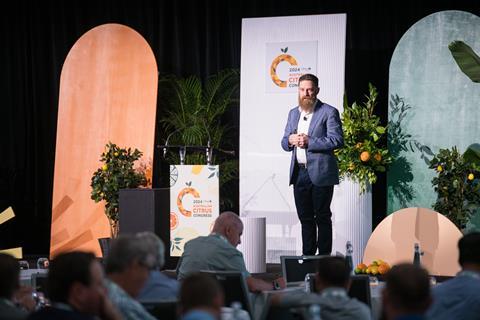Australian Citrus Congress provides insights and impetus to shape a profitable future for the Australian citrus sector

Over 420 industry members converged on the Novotel Sunshine Coast Resort for the Australian Citrus Congress run by Citrus Australia. The three-day event (5-7 March) included a main conference programme, tradeshow-style exhibition, gala dinner and biosecurity symposium.
“We were very pleased with the number of registered delegates,” said Nathan Hancock, chief executive of Citrus Australia.
“Particularly pleasing was the strong contingent of citrus growers that took time to step off their orchards and travel to the Sunshine Coast. By investing in attending, these growers invested in a profitable future for their businesses and the industry as a whole.”
In the opening keynote session, agricultural finance expert Patrick Vizzone spoke on how the changing geopolitical landscape is shaping global economies.
Based on current forecasts, Vizzone told delegates that the Australian Dollar was likely to strengthen against both the US Dollar and the Chinese Yuan over 2025 and 2026, resulting in greater price competition and lower imported input costs for Australian suppliers.
Vizzone said higher incomes would also continue to drive increased demand for premium food products in key Asian markets, including China.
In keynote session two, food and nutrition scientist Emma Beckett of FoodiQ Global suggested a new narrative was required for communicating the health benefits of citrus beyond the notion of oranges and mandarins being good sources of Vitamin C.
Beckett proposed a new paradigm that highlights the systemic health benefits of citrus, positioning the category as an “affordable superfood” that’s accessible and nutrient rich.
Citrus Australia’s inaugural Biosecurity Symposium had a core focus on Huanglongbing (HLB) disease, along with its vector the Asian Citrus Psyllid (ACP).
“While many of the delegates were alarmed by the content of these talks due to the significant risks posed by HLB and ACP, we were able to balance that out by showing how far we have come in the preparedness and protection of our industry, acknowledging we still have work to do,” said Hancock.
Breakout sessions were interspersed between the keynote presentations focusing on production, varieties, technology and post-harvest/packaging.
“We worked meticulously to design a conference programme that would help drive profitable outcomes for all delegates,” said Hancock.
“Businesses across the supply chain had the opportunity to learn something new or make a connection that will change the way they operate.”
A tradeshow-style exhibition ran alongside the conference programme on 6-7 March.
More than 25 companies from across the citrus supply chain showcased their products and services on the exhibition floor, providing attendees with the opportunity to meet new and existing suppliers and clients.
Reflecting on the near week-long programme, Hancock said the event had been a huge success.
“The inaugural Australian Citrus Congress was truly a world class event,” he said.



